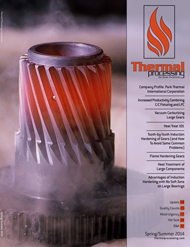When a heat treat manager or anyone responsible for purchasing heat treating equipment makes a buy decision, they must first consider the process required, then spreadsheet items such as capital and operating cost. However, I’d venture to say little—if any—attention is paid to the maintenance required, labor expertise, material handling, and their associated cost.
I’ve said it many times over the years: any heat treat company is only as good as their maintenance department. Up time or available operating time must be 95%, with few exceptions. Available up time is generally computed with scheduled down time in mind. There are 8,760 hours in one year, and when you consider the real operating time, that number of hours can become 85% of that 8,760. That’s 7,466 hours, equal to six days per week on average.
Once started, many furnaces are expected to run continuously until forced to shut down, even though no scheduled maintenance is planned. This operating option can work, as long as the failed component is located outside of the hot zone and has a spare resting in the maintenance department’s stores. This situation is what causes major grief for the production supervisor, and only experience and familiarity with the equipment can anticipate this. Assistance is generally provided by the OEM furnace supplier by a suggested spare parts list. For example, for every furnace sold by AFC-Holcroft its AMD (After Market Department) provides in addition to assembly drawings, a complete vendor listing and recommended spare parts list. This list is produced via historical data on runtime. Then about two (2) month prior to the warranty expiration AMD and AFC-H marketing alerts the customer of the impending date. Obviously the purchaser must make the final decision taking into account their experience and inventory in the maintenance department.
Carburizing furnaces can be divided into two major genres: atmosphere and vacuum. Each furnace type requires a totally different maintenance mindset; one that uses a tape measure and crowbar the other a Vernier caliper and white gloves. Atmosphere furnaces batch or continuous are designed anticipating that they likely will not receive kid-glove treatment whereas vacuum furnaces with their many sealing penetrations, water cooling cavities and critical tolerances require more attention.
Atmosphere furnaces for this discussion use endothermic gas for carburizing while vacuum systems employ vacuum pumps, acetylene and nitrogen. From a maintenance standpoint material handling will be the primary focus on atmosphere furnaces for uptime having load transfer devices inside and outside of the hot zones. Pusher furnaces as the name implies push tray-on-tray throughout the system. However, since the pusher mechanism is located outside of the hot zone, Figure 1, the condition of trays is the weak link. For that matter the same applies for atmosphere batch furnaces; trays are a major cause for unexpected but avoidable downtime events. Pusher screws or chains do fail but they can be repaired on the fly without sacrificing the parts in process, if spares are available.
With the interest in distortion control LPC and HPGQ (high pressure gas quench) systems have become more accepted, however, the carbon-carbon trays that are typically used also have a finite life that is not predictable as they are with alloy atmosphere furnace trays. Alloy trays degrade slowly over time and their condition can be readily observed so countermeasures such as inverting or rotating 180 degrees can prolong their life. Carbon-carbon trays do not bend in service, are primarily brittle and are removed when they break rendering them forever useless and unrecyclable. Alloy trays are routinely recycled back to the OEM foundry decreasing the cost of new trays. Carbon-carbon trays are extremely expensive costing tens of thousands of dollars for just one batch load of a few hundred parts.
Second to material handling are the effects of carbon on the refractory – alloy radiant tubes, fans and hearth wheels are items of concern. But again rarely due these fail without warning; symptoms of excess carbon will be evident even without analyzing the parts. A bright orange and sparkly effluent, sooty or plugged view ports, carbon pickup in quench oil are just a few indicators when using endo gas.
Endo carburizing does not have to be a dirty process. Properly sized hoods prevent carbon and oil vapor from collecting on ceilings. Routine air burnouts can reduce or eliminate soot buildup inside and out of the furnace and quench tank, especially when high CP or boost/diffuse recipes are used. Consistent use of shim analysis will indicate when the primary CP control sensors require calibration. In general the cleaner the outside of the furnace is maintained the easier it will be to monitor the interior.
Years ago semi-continuous LPC systems employed very complex internal handling systems requiring hot internal sealing doors but their runtime to failure was so poor that few remain in operation today. Material handling for batch vacuum furnaces will reside outside of the chambers on floor-rail mounted pick & place transfer cars or fork lift devices.
Vacuum pumps, vacuum tight valves, pressure sensors, O-ring, filters, nitrogen and acetylene gas valves must be the recipient of careful monitoring for proper operation and accuracy in LPC systems. No matter what LPC carburizing gas is used acetylene or propane, carbon will eventually find its way into the vacuum pump booster. The first stage booster is a “Roots” pump where the counter-rotating lobes are spaced 0.004” (.01 mm) apart. Contamination such as oil soaked carbon will at first improve evacuation time but soon will cause the pump to seize if left unchecked. The second stage can be a high RPM sliding vane pump or slower rotating reciprocating piston pump. Vane pumps due again to the small clearances can little withstand any contamination. This was a problem decades ago when ridged graphite insulation was supplied without the proper seasoning plus the sealing compound used to coat cut edges caused outgassing and clogged the vane pumps making them all but useless. Sliding piston pumps on the other hand can take more abuse. Both require routine oil replacement, filters and controlled water cooling to maintain a 160°F (71°C) operating temperature to avoid water contamination of the pump oil.
In both furnace systems carbon is the nemesis, however, it affects each furnace type quite differently: In endo gas furnaces batch and continuous, carbon is the byproduct of the CP (carbon potential) not accommodating the saturation limit in the austenite; 1.25% carbon at 1700°F (925°C) and the austenite /pearlite region below the hypo-eutectoid A3 and hyper-eutectoid Acm temperatures on the Fe-C phase diagram. If the CP is too high for the temperature excess carbon is produced since the steel part’s microstructure cannot accommodate the quantity of carbon available in the atmosphere. In LPC (low pressure carburizing) carbon is produced when the acetylene flow is too high for the surface area and temperature of the load. In addition, a portion of the hot acetylene and especially propane will crack or decompose resulting in carbon depositing in the cool space between the insulated chamber and the water jacket. As carbon accumulates it can increase evacuation time by absorbing moisture. Worse, carbon can bridge the electrically isolated heating element lead-ins and the enclosure wall creating a short circuit that can severely damage the vessel.
Pusher furnace systems can preheat the load but is not a requirement therefore the first zone is always dedicated to heating and adds no enriching gas to raise the CP, that occurs in zones two, three and so on. Atmosphere batch furnaces generally receive a cold load but there too with a new load the atmosphere is at a low default level to minimize soot drop out. The overwhelming numbers of vacuum furnaces are of the single chamber type therefore the load enters a cold environment or at least a hot chamber void of acetylene in stand-alone multi-cell systems. Since the 1960’s many multi-zone LPC or vacuum furnace configurations have been developed all with varying degrees of success, with hot doors especially being the weak link.
In the U.S. and many installations around the world, atmosphere furnaces are gas fired with radiant tubes or when required at AFC-Holcroft an electric bayonet element is inserted into the radiant tube, Figure 2. Either way carbon never reaches the actual energy production source, not so with LPC furnaces where graphite heating elements are located in direct contact with the carburizing atmosphere.
Multi-cell LPC systems, as well as the few semi-continuous vacuum LPC furnaces in production vacuum pumps, are where the excess carburizing atmosphere removed from the hot zone ends up. Inline filters and other traps can remove carbon but some still reaches the pump. Refractory lined atmosphere furnaces by comparison are burned out with air at specific intervals usually monthly or at some consistent frequency.
When either carburizing process, endo or LPC will satisfy the hardening requirement common sense dictates additional due diligence: Never overlook the maintenance. Economic and expertise are required.




























